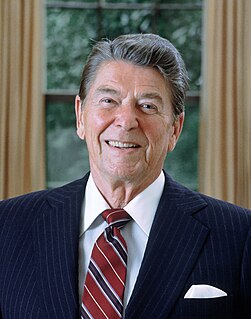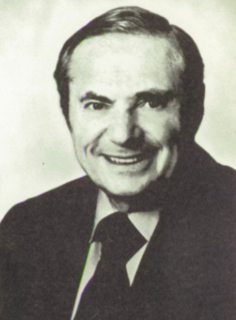
The 1932 United States presidential election was the 37th quadrennial presidential election, held on Tuesday, November 8, 1932. The election took place against the backdrop of the Great Depression. Incumbent Republican President Herbert Hoover was defeated in a landslide by Democrat Franklin D. Roosevelt, the Governor of New York and the vice presidential nominee of the 1920 presidential election. Roosevelt was the first Democrat in 80 years to win an outright majority in the popular and electoral votes, the last one being Franklin Pierce in 1852. Hoover was the last elected incumbent president to lose reelection until Jimmy Carter lost 48 years later. The election marked the effective end of the Fourth Party System, which had been dominated by Republicans.

The 1956 United States presidential election was the 43rd quadrennial presidential election. It was held on Tuesday, November 6, 1956. President Dwight D. Eisenhower successfully ran for reelection against Adlai Stevenson, the former Illinois governor whom he had defeated four years earlier.

The 1972 United States presidential election was the 47th quadrennial presidential election. It was held on Tuesday, November 7, 1972. Incumbent Republican President Richard Nixon from California defeated Democratic U.S. Senator George McGovern of South Dakota. Until the 1984 election, this was the largest margin of victory in the Electoral College for a Republican in a U.S. presidential election, and as of 2020, it remains the largest margin of the popular vote won by any Republican presidential candidate. It was the first time when California had more electoral votes than New York.

The 1976 United States presidential election was the 48th quadrennial presidential election. It was held on Tuesday, November 2, 1976. Democrat Jimmy Carter of Georgia defeated incumbent Republican President Gerald Ford from Michigan by a narrow victory of 297 electoral college votes to Ford's 240.

The 1984 United States presidential election was the 50th quadrennial presidential election. It was held on Tuesday, November 6, 1984. Incumbent Republican President Ronald Reagan defeated former Vice President Walter Mondale, the Democratic candidate, in a landslide victory, winning 525 electoral votes and 58.8 percent of the popular vote. No other candidate in United States history has matched Reagan's electoral vote total in a single election, but others have matched out his record of the popular vote 10 times by 6 other candidates. This is the most recent US presidential election in which a candidate received over 500 electoral votes.

The 2008 United States presidential election was the 56th quadrennial presidential election, held on Tuesday, November 4, 2008. The Democratic ticket of Barack Obama, the junior Senator from Illinois, and Joe Biden, the senior Senator from Delaware, defeated the Republican ticket of John McCain, the senior Senator from Arizona, and Sarah Palin, the Governor of Alaska. Obama became the first African American to be elected to the presidency, as well as being only the third sitting United States Senator elected president, joining Warren G. Harding and John F. Kennedy. Meanwhile, Biden became the first senator running mate of a senator elected president since Lyndon B. Johnson in the 1960 election.

Robert Patrick Casey Sr. was an American lawyer and politician from Pennsylvania who served as the Democratic 42nd Governor of Pennsylvania from 1987 to 1995. He served as a member of the Pennsylvania Senate for the 22nd district from 1963 to 1968 and as Auditor General of Pennsylvania from 1969 to 1977.

William Joseph Green III is an American politician from Pennsylvania. A Democrat, Green served in the U.S. House of Representatives from 1964 to 1977 and as the 94th Mayor of Philadelphia from 1980 to 1984.

Raymond Philip Shafer was an American attorney and politician who served as the 39th governor of Pennsylvania from 1967 to 1971. Prior to that, he served as the 23rd lieutenant governor of Pennsylvania from 1963 to 1967 and as a Pennsylvania state senator from 1959 to 1962. He was a national leader of the moderate wing of the Republican Party in the late 1960s.

Milton Jerrold Shapp was the 40th governor of the Pennsylvania from 1971 to 1979 and the first Jewish governor of Pennsylvania. He was also the first governor of Pennsylvania to be eligible for, and re-elected to, consecutive four-year terms per the 1968 Pennsylvania Constitution.

Raymond Joseph "Ray" Broderick was an American jurist and politician from the Commonwealth of Pennsylvania. A member of the Republican Party, he served as the 24th Lieutenant Governor of Pennsylvania from 1967 to 1971 and as a United States District Judge of the United States District Court for the Eastern District of Pennsylvania.

From January 27 to June 8, 1976, voters of the Democratic Party chose its nominee for president in the 1976 United States presidential election. Former Georgia governor Jimmy Carter was selected as the nominee through a series of primary elections and caucuses culminating in the 1976 Democratic National Convention held from July 12 to July 15, 1976, in New York City.
The Libertarian Party of the United States was formed in Colorado Springs in the home of Luke Zell by a group of individuals led by David Nolan on December 11, 1971, after several months of debate among members of the Committee to Form a Libertarian Party, founded July 17. The formation was prompted in part by price controls and the end of the Gold Standard implemented by President Richard Nixon. The Libertarian Party viewed the dominant Republican and Democratic parties as having diverged from what they viewed as the libertarian principles of the American Founding Fathers. This group included John Hospers, Edward Crane, Manuel Klausner, Murray Rothbard, Roy Childs, D. Frank Robinson, Theodora (Tonie) Nathan, and Jim Dean.

The 2012 United States presidential election was the 57th quadrennial presidential election, held on Tuesday, November 6, 2012. Incumbent Democratic President Barack Obama and his running mate, incumbent Vice President Joe Biden, were re-elected to a second term. They defeated the Republican ticket of businessman and former Governor Mitt Romney of Massachusetts and Representative Paul Ryan of Wisconsin.
The following is a timeline of major events leading up to the United States presidential election of 2012. The election was the 57th quadrennial United States presidential election and was held on November 6, 2012.

The 1974 Pennsylvania gubernatorial election was held on November 5. Incumbent Democratic Governor Milton Shapp defeated Republican Drew Lewis. Under the state's 1968 constitution, Shapp was the first governor who was eligible to run for consecutive terms.

The 1970 Pennsylvania gubernatorial election was held on November 3. Democrat Milton Shapp challenged incumbent Republican Lieutenant Governor Ray Broderick.

The 1966 Pennsylvania gubernatorial election was held on November 8. Republican Ray Shafer, the state's incumbent Lieutenant Governor, was elected to the state's highest office after holding off a charge from future governor Milton Shapp.
Andre Nigel Barnett is an American entrepreneur, politician, and model. After founding an information technology company, he was the presidential candidate of the Reform Party in the 2012 United States presidential election, and later sought a New York seat in the United States House of Representatives as a Republican.
Ronald Reagan announced his candidacy for President of the United States on November 20, 1975. Reagan won primaries in several states, but eventually lost the nomination to incumbent president Gerald Ford at the 1976 Republican National Convention.

















